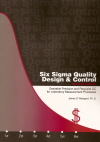Six Sigma
Six Sigma - Quality Design and Control Applications
Forget the theory and the hype about Six Sigma: What can do "in action"? It can help you to objectively assess the state of your current QC, determine the desirable CV and bias for your tests, specify the necessary QC procedures and/or needed improvements, compare all kinds of quality requirements to each other, and more. Combined with our Quality-Planning tools, Six Sigma can offer a "one-two" punch to any QC situation. (Preview)
- The ABC's of reading an OPSpecs chart
- Cholesterol: a favorite test
- What CV is desirable for routine laboratory service?
- What QC is necessary for a method just meeting NCEP requirements?
- What QC would be applicable if bias could be eliminated?
- What improvement in method CV is necessary to use QC procedures with N=2?
- Which quality requirement - clinical or analytical - is more demanding?
- What proficiency testing criterion would represent medical usefulness?
- What's the real problem with cholesterol?
- References
This article illustrates several applications of the OPSpecs chart as a Six Sigma quality design and control tool. It assumes that you have some familiarity with the OPSpecs chart - if you don't, feel free to check in the archives for a multitude of lessons. (Adopting the OPSpecs Chart as Your Planning Tool, in particular, is very helpful)
Six Sigma Quality Management can be combined with the use of OPSpecs charts to do the following:
- set performance specifications,
- select QC procedures,
- identify method improvement strategies,
- assess the benefits of method improvements,
- compare clinical and analytical quality requirements, and
- relate proficiency testing criteria to clinical quality requirements.
 Want to read more of this article?
Want to read more of this article?
We invite you to purchase the Six Sigma QC Design and Control manual, Second Edition, available at our online store. You can also download the Table of Contents and a Sample chapter.
